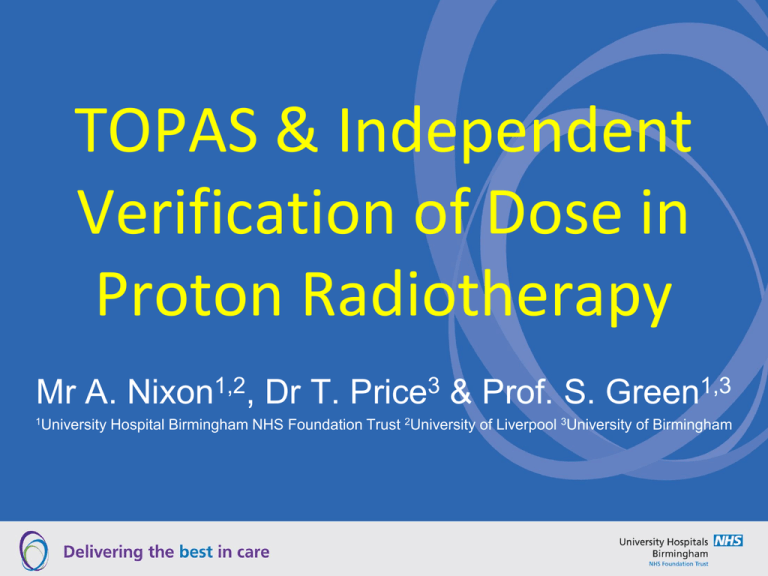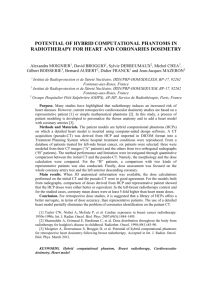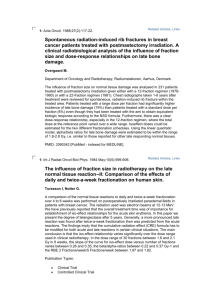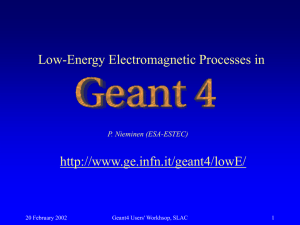TOPAS & Independent Verification of Dose in Proton Radiotherapy Mr A. Nixon
advertisement

TOPAS & Independent Verification of Dose in Proton Radiotherapy Mr A. Nixon1,2, Dr T. Price3 & Prof. S. Green1,3 1University Hospital Birmingham NHS Foundation Trust 2University of Liverpool 3University of Birmingham Introduction – Dose calculation pathway Planning and ‘final’ dose calculation MU calculation? Generation of ‘steering files’ to deliver the plan outside of the planning system Independent verification of dose delivered by ‘steering files’ Independent MU calculation? Introduction – Peer Review • Required peer review measure to independently verify MU of every radiotherapy plan produced in UK – therefore we need at least two methods of determining MU. • For photon radiotherapy: – Analytical approach taken to plan verification (e.g TG-114) for simple and 3D-CRT techniques. – Experimental technique for advanced therapies (e.g VMAT or IMRT) by verifying the plan on a homogeneous phantom. • For proton radiotherapy: – Experimental techniques to homogeneous phantoms dominate (MD Anderson Cancer Centre technique published by Zhu et al, 2011). – Some work undertaken on analytical techniques (MacKin et al, 2013 & Meier et al, 2015) Problems with the experimental approach • Time consuming and requires beamline access: – Zhu et al reported their patient-specific QA (PSQA) process takes 2 hours per plan on average. – Not possible to treat patients while the bunker is being used for PSQA. – 15 new patients a week will take a lot of beam (and staff) time! • Adaptive planning will require (a lot) more than one validation per patient. – IMPT is very sensitive to anatomical changes during treatment (Williams et al, 2015 & Müller et al, 2015). Are we verifying the distribution or delivery? • Patients are not homogenous phantoms. • Planning algorithms are well validated against water and other phantom materials at commissioning and during development. • We’re not testing the plan calculated on the patient geometry. • Routine QA should be robust enough to tell us if the beam is behaving as we expect. A Monte Carlo approach? • Pros: – Well verified physics. – As a verification of dose there is a reduced requirement for time saving optimisations which increase uncertainty in some conditions. – Little end-user input or time required in a well designed system. – Doesn’t just prove the planning system can calculate dose to water! • Cons: – CT number to material (or stopping power) conversion subject to uncertainty. – Relies on comprehensive routine QA procedures. – Variance reduction and track killing techniques must be carefully implemented TOPAS - TOol for PArticle Simulation • Interface to Geant4 9.6 • As stated in Perl et al 2012: – Preserve the underlying Geant4 code. – Deliver the full capabilities of Geant4 in terms of speed, accuracy, and flexibility. – Offer a well benchmarked underlying physics. – Support users who have limited or no programming expertise. – Introduce the routine use of Monte Carlo to the proton therapy community. • As it’s based on Geant4 it inherits bugs, quirks etc as well as introducing its own. University of Birmingham MC40 Cyclotron • Cyclotron typically used to produce beams of 29 MeV or 36 MeV protons. • Choice of either pencil beam or scattered beam. • Fixed collimation system in development. • Monitor chamber in place before the collimator system. ~400 lines of code in TOPAS Vs ~3500 lines of code in Geant4 36 MeV Validation • Bragg peak validated with Markus chamber. • Lateral spread validated with Gafchromic film. Plexiglass or G4_PLEXIGLASS? • • • • • TOPAS model used G4_PLEXIGLASS while Geant4 model reproduced NIST composition manually. The same parameters in TOPAS implied the energy was too low, even with the same density and I value. G4 materials (NIST) ‘attach various corrections to models of ionization’. Geant4 is not good at documenting this behaviour! This may have an impact in simulations of materials where it’s difficult to perform measurements. Modelling an ionization chamber – Charge collection • • Model the charge collected by an ionisation chamber using a simple model ( Based on Paganetti 2006). – Not possible to model ionrecombination with MC. – Assume all charge created inside the active volume is collected. – Can be related to the dose to the ionization chamber, Dic. Convert Q(Dic) to an output factor (in units of Gy nC-1), ψ, by considering dose to reference point, Dref. Discussion Questions • Is there an established QA programme that would be sufficient to guarantee good delivery of a planned fluence distribution in spot-scanned proton radiotherapy? • Is it reasonable to ask a MC code to simulate charge collected in an ion chamber? • How much beamline do we need to simulate to validate the ‘steering files’? • Is there a better way to solve this problem computationally? • Do we simulate with the correct materials when we’re mapping from a CT scan?



